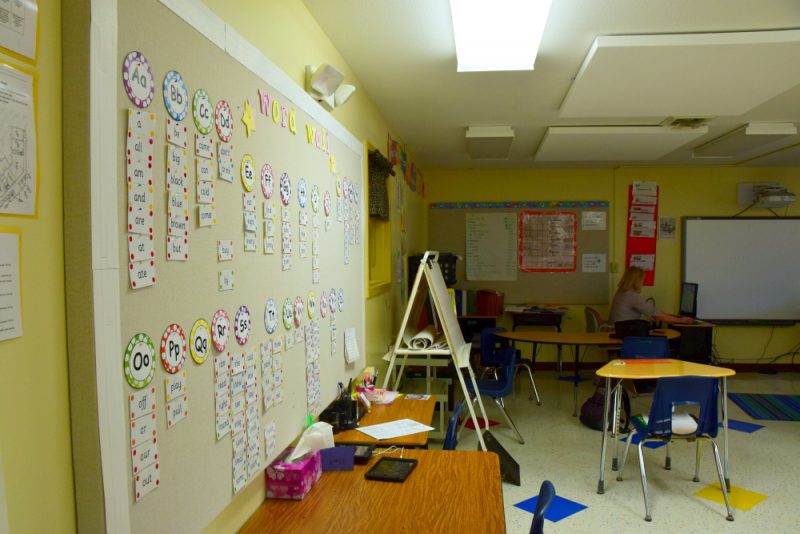I
t’s 9 a.m. on a school day. Kids get off buses and stream into the brick building on the corner of Bethel Street and Southampton Drive. Despite the commonplace nature of the scene, both the students and the school are unique. Behind the walls of the Center of Responsive Education (CORE) is an environment meant to serve any student who needs specialized support.
Connie Divine, a CORE administrator since 2005, believes the school is critical for the small percentage of students who don’t thrive in a traditional education setting. Since the staff is trained to deal with outbursts and behavioral ticks, kids are more likely to stay and learn throughout the day instead of having to go home midday.
“We basically analyze students’ behavior and try to change things in their environment and support them once we find out what their problems are so that their poor choices and behavior is less likely to happen,” Divine said. “It isn’t necessarily a fix because they do have disabilities, but it’s finding the support and strategies and environment that will make that behavior not effective anymore.”
Even with the emphasis faculty places on fixing student conduct, teacher Bonita Fitzmaurice said CORE is an educational program above all. Therefore, when Fitzmaurice compares CORE to past teaching experience, the sole purpose of teaching is still present in addition to the success from breakthroughs.
“I like both [teaching at regular schools and CORE, but] I like this a little more because when you have success, you feel like you’ve changed a kid’s life because you’ve taken them off this path and hopefully put them on a path to be more successful,” Fitzmaurice said. “It can be heartbreaking, too, because when they’re successful, they leave. So they go back to their regular schools, and your hope is that you don’t see them again back at this program.”
Similarly to other schools, CORE provides reinforcement and incentive for behaving respectfully and responsibly. Whenever a student does something positive, they receive a “cue,” or a piece of paper that can be used for rewards. CORE also utilizes a five level system where each stage offers new privileges. The ultimate goal, however, is for the student to go back to his or her district school. Fitzmaurice enjoys seeing her kids progress toward independence.
“When they start, they’re on level one. We’re trying to get them through the levels. When they get to level four, that’s when we talk about getting them back to regular schools,” Fitzmaurice said. “They’re really proud when they get to level five, and they can walk in the hall with a pass without an adult — that’s a big thing for them. [They] get to sit at a special table at lunch, and talk about going back to their schools.”
Of course, working with kids can always be challenging, especially when they are troubled. To ensure students’ safety, many of the doors in CORE have to be locked. Regardless of this seemingly extreme aspect of the school, such measures are necessary to maintain a controlled environment. Learning specialist Valerie Broderick thinks keeping order greatly benefits the kids.
“[CORE] provides structure and predictability. Some of these kids have very little structure; they don’t know who’s going to be home when they get home,” Broderick said. “When they come here, they know exactly what to expect from 9 o’clock to 3 o’clock when they leave.”
So, while the plain exterior and generic name of the CORE building down the street may leave drivers wondering exactly what happens there, for many Columbia families, the support CORE offers is fundamental to their child’s education. Faculty members like Divine feel a strong pull to work with kids with disabilities through both the good times and the bad.
“[Working with students who have disabilities is] sometimes scary, and it can make you very anxious, but everyone here has been here for a long time, and they feel like this is their purpose. So I think that the kids feel that and know that,” Divine said. “It does get aggressive here. [Anger] isn’t necessarily [directed] at you, but they can punch walls and toss a chair, but sending kids home doesn’t fix the problem. Making sure we talk [and] find out reasons for the problem [is important] so we that can work on situational devices and strategies.”
LATEST NEWS
- Stress, anxiety skyrocket as students prepare for upcoming AP tests
- RBHS holds successful night of percussion
- Not even water?
- Solar eclipse to pass through Missouri, April 8
- How CPS is organized: a guide
- City of Columbia to hold school board election April 2
- Youth Election Participants to assist in upcoming municipal election
- City of Columbia hosts first Community Engagement Session for McKinney Building, hopes to gain public insight on the structure’s future
- RBHS Track Team Opener at Battle Gallery
- March Mathness Photo Gallery





















































































